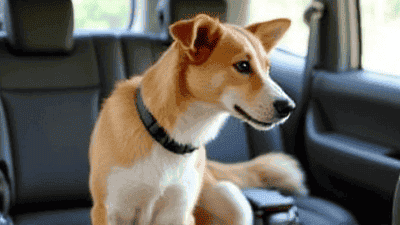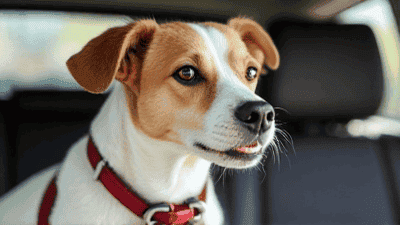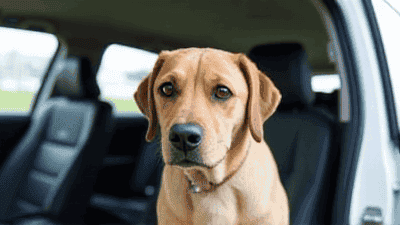
Hitting the open road with your furry friend can be an exciting adventure, but it also requires careful planning to ensure your pet’s safety and comfort. Whether you’re traveling across town or across the country, creating a safe and enjoyable environment in the car is essential for a successful road trip with your pet.
Before embarking on your road trip, schedule a checkup with your veterinarian to ensure your pet is healthy and up-to-date on vaccinations. Discuss any travel concerns, such as motion sickness or anxiety, and ask for recommendations on medications or calming aids.
Make sure your pet’s ID tags and microchip information are current. Include your contact details and destination address in case your pet gets lost during the trip.
Prepare a travel kit with essentials such as:

A pet seat belt or harness can keep your pet secure and prevent them from moving around the car. Ensure the harness is properly fitted and attaches to the car’s seat belt system.
If your pet is small, a well-ventilated carrier or crate can provide a safe and comfortable space. Secure the carrier with a seat belt to prevent it from sliding during the ride.
For larger pets, consider installing a car barrier to separate the back seat from the front. This keeps your pet contained and reduces distractions while driving.
Protect your car seats from scratches, hair, and accidents with a durable car seat cover. Look for one with waterproof and non-slip features.
Pets are sensitive to extreme temperatures, so maintain a comfortable climate inside the car. Use air conditioning during hot weather and avoid leaving your pet in the car unattended.
Use window shades or tinted glass to block direct sunlight, which can cause overheating. Ensure your pet has access to shade and water at all times.
If your pet is sensitive to noise, consider using white noise or calming music to drown out traffic sounds. This can help reduce anxiety and create a more relaxing environment.
Bring along your pet’s favorite blanket, toy, or bed to provide a sense of security and comfort during the trip.

Never allow your pet to roam freely in the car, as this can be dangerous for both the pet and the driver. Use a seat belt, carrier, or barrier to keep them safe.
The front seat is not a safe place for pets, especially if the car has airbags. Place your pet in the back seat or cargo area instead.
Schedule regular stops to allow your pet to stretch, relieve themselves, and hydrate. Aim for a break every 2-3 hours.
Watch for signs of stress, such as excessive panting, whining, or restlessness. Adjust your plans if your pet seems uncomfortable or overwhelmed.
Feed your pet at the same times as you would at home to avoid digestive issues. Offer a light meal before the trip to prevent motion sickness.
Feed your pet during breaks, as eating in a moving vehicle can cause choking or discomfort.
Keep a portable water bowl or dispenser handy and offer water regularly to prevent dehydration.

Use natural calming remedies, such as pheromone sprays or CBD oil, to help your pet relax. Consult your vet for recommendations.
If your pet is not used to car rides, take short trips to help them get accustomed to the motion and environment.
For pets prone to motion sickness, ask your vet about safe and effective medications to reduce nausea.
Bring along toys that can keep your pet occupied, such as puzzle feeders or chew toys.
Use breaks to engage your pet in simple training exercises or games, like fetch or hide-and-seek.
Play calming music or an audiobook to create a soothing atmosphere for your pet.
Before your trip, identify pet-friendly hotels, parks, and rest areas along your route. Apps and websites like BringFido can help you find suitable options.
Be aware of local leash laws and pet restrictions in the areas you’ll be visiting.
Give your pet opportunities to explore and enjoy the outdoors during breaks. Look for dog parks or hiking trails where your pet can safely roam.
Pack a pet first aid kit with items like bandages, antiseptic wipes, tweezers, and a pet-safe pain reliever.
Keep a list of emergency contacts, including your veterinarian and nearby animal hospitals along your route.
Consider purchasing pet travel insurance to cover unexpected medical expenses or accidents.
Dogs are typically the most adaptable pets for road trips. Provide plenty of exercise and mental stimulation to keep them happy.
Cats may be more resistant to car travel. Use a secure carrier and create a calm environment to reduce stress.
For rabbits, guinea pigs, or birds, ensure their carrier is well-ventilated and stable. Avoid sudden movements or loud noises.
If you’re traveling with reptiles or other exotic pets, research their specific needs and ensure they have proper heating and humidity.
A road trip with your pet can be a memorable bonding experience, but it requires careful planning to ensure their safety and comfort. By preparing in advance, choosing the right gear, and creating a pet-friendly environment in the car, you can make the journey enjoyable for both you and your furry companion. Remember to prioritize your pet’s needs, stay vigilant during the ride, and plan plenty of breaks to keep them happy and healthy. With these tips, you’re ready to embark on a fun and stress-free road trip with your pet.